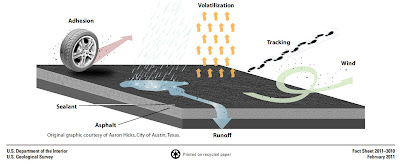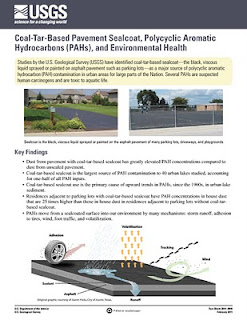 |
| Illustration from New USGS Publication |
Over the last few years, the research into the problem of coal tar sealants has covered a variety of specific areas including the wash off, wear off, parking lot dust, household dust, biological effects and lake cores. All of these studies have increased our understanding of the sealants and the challenge they present in the environment. Until now it has been a little tough for the less scientific among us to track all of these studies.
• Coal-tar-based sealcoat is the largest source of PAH contamination to 40 urban lakes studied, accounting for one-half of all PAH inputs.
• Coal-tar-based sealcoat use is the primary cause of upward trends in PAHs, since the 1960s, in urban lake sediment.
• Residences adjacent to parking lots with coal-tar-based sealcoat have PAH concentrations in house dust that are 25 times higher than those in house dust in residences adjacent to parking lots without coal-tar-based sealcoat.
• PAHs move from a sealcoated surface into our environment by many mechanisms: storm runoff, adhesion to tires, wind, foot traffic, and volatilization.
And some take away factoids:
Coal-tar pitch is 50 percent or more PAHs by weight and is known to cause cancer in humans (International Agency for Research on Cancer, 1980).
Coal-tar-based sealcoat products typically are 20 to 35 percent coal-tar pitch.
Product analyses indicate that coal-tar-based sealcoat products contain about 1,000 times more PAHs than sealcoat products with an asphalt base (City of Austin, 2005)
PAH concentrations in the coal-tar-based sealcoat product are about 1,000 times higher than in the asphalt-based product (more than 50,000 milligrams per kilogram [mg/kg] in coal-tar-based products and 50 mg/kg in asphalt-based products.
Concentrations of PAHs in dust swept from sealed parking lots in central and eastern U.S. cities, where coal-tar-based-sealcoat use dominates, were about 1,000 times higher than in western U.S. cities.

